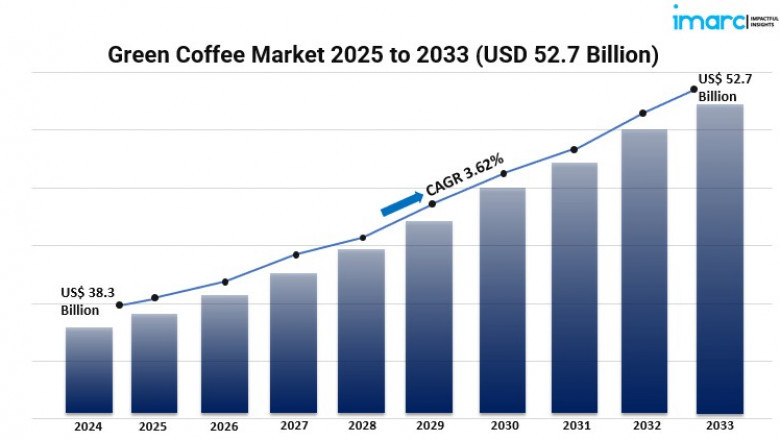views
The global green coffee market is experiencing significant growth, driven by rising consumer interest in specialty and sustainable coffee products. In 2024, the market reached a value of USD 38.3 billion and is projected to grow at a CAGR of 3.62%, reaching USD 52.7 billion by 2033. This expansion is fueled by increasing coffee consumption, the growth of e-commerce platforms, and a shift towards premium, unique coffee experiences.
Study Assumption Years
- Base Year: 2024
- Historical Years: 2019–2024
- Forecast Years: 2025–2033
Green Coffee Market Key Takeaways
- Market Size & Growth: The global green coffee market was valued at USD 38.3 billion in 2024 and is expected to reach USD 52.7 billion by 2033, growing at a CAGR of 3.62% during 2025–2033.
- Consumer Preferences: There's a growing demand for specialty and premium coffee products, reflecting consumer preferences for unique and sustainable options.
- E-commerce Expansion: The significant growth of the e-commerce sector has made green coffee products more accessible to a broader consumer base.
- Health Awareness: Increasing awareness of the health benefits associated with green coffee, such as antioxidant properties, is contributing to market growth.
- Regional Production: Countries like Brazil, Colombia, and Ethiopia are dominating the supply chain due to favorable climate conditions and investments in coffee cultivation.
- Product Traceability: The popularity of single-origin and micro-lot green coffee beans is meeting consumer demand for distinctive flavor profiles and product traceability.
What Are the Key Factors Fueling the Growth of the Green Coffee Market?
Rising Demand for Specialty and Premium Coffee
Rising consumer demand for specialty and premium green coffee goods is fueled by their growing desire for distinct coffee experiences. This tendency is defined by a preference for single-origin and micro-lot beans, which provide more openness in sourcing and distinctive flavor profiles. The market is changing thanks to an emphasis on quality and traceability, which motivates growers to concentrate on growing premium coffee types.
Expansion of E-commerce Platforms
The expansion of e-commerce has increased consumer reach and product accessibility, both of which have materially affected the green coffee sector. From the comfort of their homes, online marketplaces let customers investigate a wide selection of green coffee products, contrast choices, and make wise buying decisions. Greater sales and smaller producers' entry into the market to reach a worldwide audience have both resulted from this simplicity.
Health and Wellness Trends
The rising knowledge of health and wellness has shaped consumer behavior, with many people looking for organic and healthy goods. Seen as a wise drink option, green coffee has strong antioxidant qualities and high chlorogenic acid content. This view has increased its appeal among customers aware of health, hence fueling market expansion.
Market Segmentation
By Type
- Arabica: Known for its mild flavor and lower caffeine content, Arabica beans are highly sought after in specialty coffee markets.
- Robusta: Robusta beans have a stronger, more bitter flavor and higher caffeine content, making them popular for espresso blends and instant coffee products.
By Product
- Roasted Coffee: Green coffee beans that have been roasted to develop flavor and aroma, commonly used in various brewing methods.
- Instant/Soluble Coffee: Processed green coffee beans that are brewed and then dried into a soluble form for quick preparation.
- Green Coffee Bean Extract: A concentrated form of green coffee used in dietary supplements and health products for its potential health benefits.
By Distribution Channel
- Hypermarkets and Supermarkets: Large retail outlets offering a wide range of green coffee products to consumers.
- Departmental Stores: Retail stores that provide green coffee products as part of their grocery and specialty food sections.
- Specialty Stores: Shops focusing on coffee and related products, offering curated selections of green coffee beans.
- Online: E-commerce platforms that sell green coffee products directly to consumers, providing convenience and variety.
- Others: Includes smaller retail outlets and alternative distribution methods catering to niche markets.
By End User
- Retail: Individual consumers purchasing green coffee products for personal use.
- Coffee Cafes: Establishments that prepare and serve coffee beverages, often sourcing green coffee beans for in-house roasting.
- Others: Includes businesses and institutions that utilize green coffee products for various purposes.
Breakup by Region
- North America (United States, Canada)
- Asia Pacific (China, Japan, India, South Korea, Australia, Indonesia, Others)
- Europe (Germany, France, United Kingdom, Italy, Spain, Russia, Others)
- Latin America (Brazil, Mexico, Others)
- Middle East and Africa
Which Region Is Leading the Green Coffee Market?
Driven by a robust consumer base that appreciates specialty and sustainable coffee products, North America is now dominating the green coffee market. The region's sophisticated e-commerce system and great health and wellness consciousness help to explain its leading position in the market.
What Are the Latest Developments in the Green Coffee Market?
Recent changes in the green coffee sector include more investment in coffee growing in countries like Brazil, Colombia, and Ethiopia, therefore improving production capacities. Furthermore contributing to market diversification, there is a rising trend toward the growing of specialty green coffee in areas such like East Africa and Central America, which offers distinctive flavor profiles.
Who Are the Key Players in the Green Coffee Market?
Atlantica Coffee (Montesanto Tavares Group), Belco S.A., Golden Bean Trade, Merchants of Green Coffee, Neumann Kaffee Gruppe, Nordic Approach AS, The Bean Coffee Company, The Green Coffee Brazil (Group MAGNUS BRAZIL), WSCafe, etc.
If you require any specific information that is not currently covered within the scope of the report, we will provide the same as a part of the customization.
About Us:
IMARC Group is a global management consulting firm that helps the world’s most changemakers to create a lasting impact. The company provides a comprehensive suite of market entry and expansion services. IMARC offerings include thorough market assessment, considerations studies, company incorporation assistance, factory setup support, regulatory approvals and licensing navigation, branding, marketing and sales strategies, competitive landscape and benchmarking analyzes, pricing and cost research, and procurement research.














Comments
0 comment